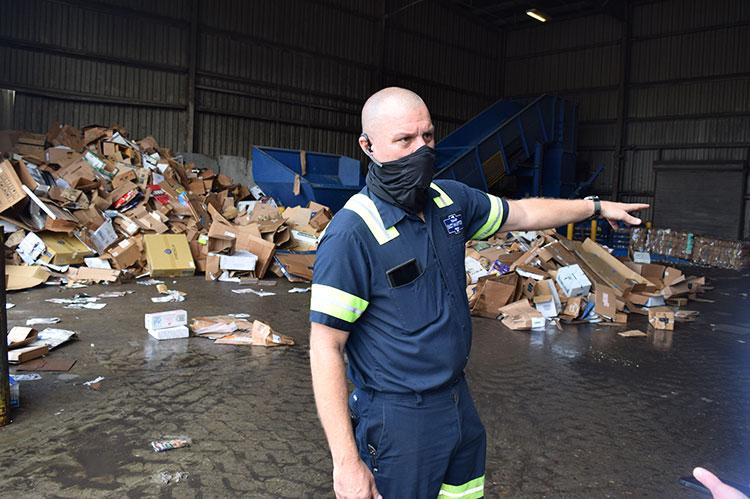Since March, when fear of Covid-19 drove many second-home owners into town prematurely, and many of them permanently, the East Hampton Recycling Center has absorbed a vast surge in recyclable and non-recyclable materials. All 21 employees at the center, adjacent to the capped landfill on Springs-Fireplace Road, have been on the job full time since then -- among the most essential of essential workers.
Consider how life has changed since the pandemic emerged. Whether people have lived here for 70 years or six months, many are avoiding in-store purchases in favor of online delivery. That means cardboard -- lots and lots of cardboard -- and the staff at the recycling center is tasked with baling it for sale and shipment out of town. As of last week, said Craig Fick, the center's crew leader and a 25-year veteran there, the center has received 200 more tons of cardboard than during the same period in 2019. "The price fluctuates so much," Mr. Fick said. "We put it out to bid every week, so we're getting the best dollar we can for the town residents. I believe the last bid I saw was $50 per ton."
"It just shows that people get stuff shipped in," he said.
The sale of recycled newspaper ($55 per ton) and mixed paper ($35) also means revenue for the town and helps keep associated costs down. An annual permit to use the recycling center costs $115; a per-trip pass is $20.
It seems, though, that some new residents are accustomed to single-stream recycling, in which all materials, from aluminum to glass to paper, are put in a single bin, to be sorted at a facility later. This introduces contamination. At the recycling center, for example, a long cardboard box in which a flat-screen television had been shipped lay on the floor of a cavernous, open-air room in which cardboard is bundled for shipment. The TV set had been removed, but the Styrofoam that surrounded it was still inside. "That's it, that's the end of its life," Mr. Fick said of Styrofoam. "You can't do anything with it. For our cardboard, it contaminates it, so we have to pull it out."
Contamination is also a problem in the bins designated for other materials, such as newspaper, mixed paper, plastic, and glass. A sign at each bin stipulates the material to be deposited, and, in the case of cardboard, how it is to be deposited (flattened and dry). "Our signage is plain," Mr. Fick said. "The problem is, residents don't read them sometimes, or are in too big a hurry to pay attention. We rely a lot on resident participation. If they are not participating, it just makes our job harder." The mixed-paper bins, he said, "become a catch-all. Everybody just throws everything right in."
Newspaper, he said, "is one of our biggest and hardest ones to keep clean," perhaps owing to that single-stream mindset. In a mixed-paper bin, he pointed to cardboard and books. Plastic bottles were sprinkled among the glass in the glass bin.
Given the facility's function, it is surprisingly clean, thanks mostly to the staff. The floors near the bins for nonrecyclables -- household garbage -- can be an exception. "People come in with their garbage pails and they dump their garbage and then knock it on the wall or knock it on the ground," Mr. Fick said. "Now everybody is walking in somebody else's slime, and spreading broken glass and everything else. The guys do their best to keep it clean, but if everybody knocks their barrel on the ground, it's tough."
With that said, "We are fortunate that the residents do a lot here," he continued. "We rely on them separating, and they do a good job of it. It's just little things here and there that could make it better."
The volume of construction debris taken to the recycling center is up by about 10 percent this year, Mr. Fick said. The facility also receives such things as computers, tires, large appliances like refrigerators and washing machines, and scrap metal, for which separate fees are assessed based on weight. Lawn clippings and brush are turned into compost and sold to landscapers and residents. "We sell a lot," Mr. Fick said. "I want to say 7,000 tons this year."
Twice each year, the town's energy sustainability advisory committee sponsors STOP Day, for Stop Throwing Out Pollutants. The next STOP is on Nov. 7, from 9 a.m. to 2 p.m. at the Montauk transfer station. Residents can take in, for example, antifreeze, bleach, pesticides, fertilizers with herbicides, flammable liquids, oil-based paints, solvents, and paint thinners for safe disposal.
On June 27, when STOP Day was held in East Hampton, "participation was up" by 50 to 60 vehicles, Mr. Fick said, "because everybody was home because of Covid, so it was 'Let's clean out the house.' You hope participation stays high."
That goes for the proper dispatch of everything, said Councilwoman Sylvia Overby, the town board's liaison to the energy sustainability committee, which recently added litter to its scope. "The reason you want to do it," she said of recycling, "is to keep it out of the landfill. And we all pay for trucking it to a landfill. The fewer trucks going UpIsland and to other places, the better off we are."
Ms. Overby encouraged a wider view of conservation, to include "reduce" and "reuse" alongside "recycle." "If we can take [reusable] bags to the grocery store and get loose items -- not packaged in a plastic container -- those are the things we should concentrate on. Recycling is the way, once we have it, but let's not have so much of it running through our lives. That's the focus in the energy sustainability committee, because we don't want to have to produce all this plastic."
The message boils down to, Do the Right Thing. "If you're going to take the time at home to recycle," Mr. Fick said, "when you get here, don't be in such a rush just to throw it in any bin. If you separate it, we do what we have to do. If you're unsure, the signs are there."
Also, he reminded, "Wear your mask when you come in. It's for everybody's sake."




